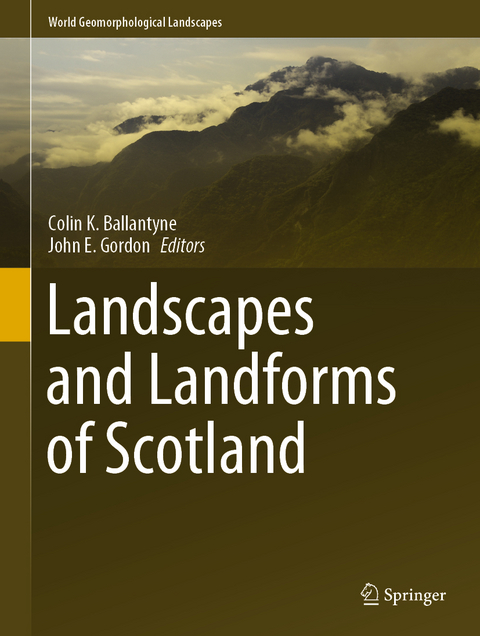
Landscapes and Landforms of Scotland
Springer International Publishing (Verlag)
978-3-030-71245-7 (ISBN)
Colin K. Ballantyne is Emeritus Professor of Physical Geography at the University of St Andrews and a Fellow of the Royal Society of Edinburgh, the Royal Scottish Geographical Society, the Geological Society and the British Society for Geomorphology. He has published over 200 papers on various aspects of geomorphology and Quaternary science, many of which concern Scotland. His recent books include The Quaternary of Skye (2016), Periglacial Geomorphology (2018) and Scotland's Mountain Landscapes: a Geomorphological Perspective (2019). He is an Honorary Life Member of the Quaternary Research Association and a recipient of the Clough Medal of the Edinburgh Geological Society, the Saltire Earth Science Medal, the Gordon Warwick Medal and Wiley Award of the British Society for Geomorphology, the President's Medal, Coppock Research Medal and Newbigin Prize of the Royal Scottish Geographical Society, and the Lyell Medal of the Geological Society. John E. Gordon is an Honorary Professor in the School of Geography and Sustainable Development at the University of St Andrews, Scotland. His research interests include geoconservation, the Quaternary of Scotland, and mountain geomorphology and glaciation in North Norway and South Georgia. He has published many academic papers and popular articles in these fields, and is co-author/co-editor of books including Quaternary of Scotland (1993), Antarctic Environments and Resources (1998), Earth Science and the Natural Heritage (2001), Land of Mountain and Flood: the Geology and Landforms of Scotland (2007) and Advances in Scottish Quaternary Studies, a special issue of Earth and Environmental Science Transactions of the Royal Society of Edinburgh (2019). He is a Fellow of the Royal Scottish Geographical Society, an Honorary Member of the Quaternary Research Association and a Deputy Chair of the Geoheritage Specialist Group of the IUCN World Commission on Protected Areas.
Landscapes and Landforms of Scotland: a Geomorphological Odyssey.- Part I Physical Environment: Scotland: Geological Foundations and Landscape Evolution.- Long-term Denudation and Geomorphology in Scotland.- The Quaternary in Scotland.- Scotland's Changing Landscape.- Part II Landscapes and Landforms: Geomorphology of the Continental Shelf.- Shetland.- Orkney and Caithness.- The Outer Hebrides and St Kilda.- The Islands of the Hebridean Igneous Province: Skye, Mull, Rùm and Arran.- The Islands of Islay, Jura, Colonsay, Tiree and Coll.- The Far Northwest: Sutherland, Assynt and Coigach.- Wester Ross.- Rock-slope Failures in the North West Highlands.- The Glacial Geomorphology around Inverness and the Great Glen.- Glen Roy and Glen Spean.- Western Grampian Highlands.- The Cairngorm Mountains.- Fluvial Landforms of Glen Feshie and the Spey Drainage Basin.- Central and Eastern Grampian Highlands.- The Buchan Palaeosurface.- Beaches and Dunes of the Moray Firth Coast.- Beaches and Dunes of Eastern Scotland.- Loch Lomond, Menteith and the Forth Valley.- Glacifluvial and Glacilacustrine Landforms of the Midland Valley.- The Midland Valley: Ice-moulded Lowlands.- Upland Landscapes and Landforms of the Southern Uplands.- The Solway Lowlands and Coast.- Part III Geoheritage, Scotland's Geomorphological Heritage and its Conservation.- Index.
"This volume will ... be a valuable addition to university or personal libraries and serve as a great first introduction to delve deeper into the broad and fascinating research history of the geomorphological legacy preserved in Scotland. Readers of The Holocene will find several chapters that mainly deal with Holocene active processes and landforms particularly helpful in this endeavour." (Sven Lukas, The Holoscene, Vol. 33 (4), 2023)
“This volume will … be a valuable addition to university or personal libraries and serve as a great first introduction to delve deeper into the broad and fascinating research history of the geomorphological legacy preserved in Scotland. Readers of The Holocene will find several chapters that mainly deal with Holocene active processes and landforms particularly helpful in this endeavour.” (Sven Lukas, The Holoscene, Vol. 33 (4), 2023)
| Erscheinungsdatum | 26.08.2021 |
|---|---|
| Reihe/Serie | World Geomorphological Landscapes |
| Zusatzinfo | XIV, 503 p. 273 illus., 242 illus. in color. |
| Verlagsort | Cham |
| Sprache | englisch |
| Maße | 210 x 279 mm |
| Gewicht | 1739 g |
| Themenwelt | Naturwissenschaften ► Geowissenschaften ► Geografie / Kartografie |
| Naturwissenschaften ► Geowissenschaften ► Geologie | |
| Schlagworte | Alpine Mountains • Caledonian Mountains • Geoheritage • Geotourism • Ice Age Scotland • Scotland Geomorphology |
| ISBN-10 | 3-030-71245-1 / 3030712451 |
| ISBN-13 | 978-3-030-71245-7 / 9783030712457 |
| Zustand | Neuware |
| Haben Sie eine Frage zum Produkt? |
aus dem Bereich


